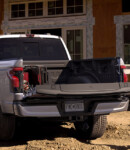The most popular vehicle line in the US now includes a battery-electric pickup truck. Is this the turning point for EVs?
Wednesday evening, Ford unveiled its long-awaited battery-electric pickup truck, dubbed the F-150 Lightning.
The name hearkens back to “the fastest truck in the world,” the Lightning F-150 SVT, which launched in 2002 with a high-performance V-8. But this is the 2020s, and Ford has repurposed the name for what will become its fastest-accelerating full-size pickup truck.
Ford got some help from a self-described “car guy” named Joe Biden, now President of the United States of America. On Tuesday, at Ford’s Rouge Electric Vehicle Center, he spoke in favor of increased investment in electric vehicles and charging infrastructure—while standing in front of the truck. It was seen by millions and appeared all over the day’s news coverage.
Biden then visited Ford’s Romeo Proving Ground, where he drove an actual prototype electric F-150—and raved about the Ford’s electric acceleration. “This sucker’s quick,” he said. The president cited a 0-to-60-mph time of just 4.4 seconds, more than a second quicker than the SVT Lightning of two decades earlier.
Biden didn’t mention battery range, but that critical EPA rating is expected to come in at around 230 miles for the Standard Range pack, 300 miles for the Extended Range. That’s roughly equivalent to the ranges promised for the Mustang Mach-E launched last year. Still, GM said in April it will offer a battery-electric version of its competing Chevrolet Silverado pickup with 400 miles of range. Let the pickup range wars begin.
Performance, onboard power…and a front trunk
As it has done with hybrids, Ford is pitching the performance and onboard power aspects of its EV models. Climate change doesn’t rate a mention, and “zero emissions” appears only sporadically. It’s not a bad strategy, because Americans care more about fast acceleration and the ability to use power tools in the wilderness than about melting ice caps or carbon footprints.
While the F-150 Lightning largely resembles the rest of the sprawling F-150 lineup, it turns out to be quite different underneath. The only carryover sheet metal is the Crew Cab body and the structure of the pickup bed. The front suspension is also common to gasoline and diesel versions—but that’s about it.
The company designed a brand-new frame to accommodate a large, flat battery pack stretching almost from side to side, axle to axle. The Lightning is the first-ever F-Series pickup truck with independent rear suspension. And of course, rather than a transmission and associated 4WD gearing, it uses one electric motor on either end to provide all-wheel drive.
A feature that proved hugely popular in clinics, said Darren Palmer, Ford’s North American EV Manager, is the front trunk. It’s reached by opening the power-operated hood, actually a new one-piece unit that includes the blanking plate that serves as a “grill.” That opens right down to bumper level, giving owners a 14-cubic-foot lockable storage compartment. It includes a hidden compartment below the floor, plus a drain plug so you can just hose it out if you’ve stored something dirty or smelly (Ford suggested used athletic gear).
One configuration, two battery options
Today, the F-150 Lightning comes in only one body style—the Crew Cab that Ford says is the most popular of all F-150 configurations for private buyers, with a 5.5-foot pickup bed. Two motors are standard, though buyers can choose between the Standard Range and Extended Range battery packs.
Ford was coy about pack capacities—Palmer explained that the company wants journalists to focus on what the truck delivers to customers. But the cited charging rates and durations would indicate capacities of roughly 150 to 160 kilowatt-hours for the Extended Range battery and 110 to 115 kWh for the Standard.
Ford is quite willing to share other specs, though. It quotes 0-to-60-mph acceleration in the “mid 4 second” range, about 1 second quicker than the F-150 Raptor—its current performance pickup—which comes in at 5.5 seconds.
Peak motor torque for all Lightnings is a whopping 775 pound-feet, which Ford says is the highest for any F-150 ever built. Motor power varies with pack size. The F-150 Lightning with the Standard Range battery is quoted at 318 kilowatts (426 horsepower) of peak output, while the Extended Range battery boosts that to 420 kW (563 hp).
Payload and towing are inevitably on the minds of any truck buyer. Payload is listed as 2,000 pounds in the Standard Range model, though it falls to 1,800 pounds in versions with the heavier Extended Range pack. Towing capacity with the larger battery is rated up to 10,000 pounds with the Max Trailer Tow package, or 7,700 pounds for the Standard pack. Ford executives declined to characterize the effect of towing on battery range, beyond saying it was “roughly” equivalent to that of a gasoline or diesel vehicle—often quantified as a fuel-consumption hit of up to 50 percent.
Home charging options up to 80 amps
Large swathes of F-150 Lightning shoppers may be new to EVs, and they will inevitably ask about charging. Ford has answers—a lot of answers, in fact.
The portable charging cord that comes with the truck has pigtails for 120-volt and 240-volt plugs, the latter with a capacity of up to 32 amps. At best, that requires 14 to 19 hours to charge the pack from 15 to 100 percent.
The standard home charging station runs at 80 amps, though it will likely require some garage rewiring. The Lightning itself comes with dual onboard chargers, meaning the Extended Range version can charge from 15 to 100 percent of battery capacity in about 8 hours, or overnight. It’s 10 hours for the smaller pack.
As for DC fast charging, as it does for the Mach-E, Ford uses the CCS standard, and has trip planning and routing built into the navigation and the FordPass app. The maximum charging rate is 150 kW, but Ford declined to specify under what circumstances that rate could be achieved or how long it was sustained. If the Mach-E pack is any guide, that maximum rate can be reached only at low states of charge, and the rate steps down in several increments starting well before 50 percent.
Using a 150 kW charging station, Ford quotes fast-charging times from 15 to 80 percent of 44 and 41 minutes for the Standard and Extended batteries, respectively. Old-style 50 kW CCS sites, however, will take 91 and 122 minutes (that’s a grim two hours) to deliver that same increment.
Power appliances, even your home, with your truck
Perhaps the most interesting marketing pitch for the F-150 Lightning is its ability to provide backup power to a home. With the 80-amp charging station that’s standard with the bigger pack, optional for the Standard battery, plus an optional home energy management system—installed by Sunrun, which will also offer owners the chance to add solar panels while they’re at it—a fully charged F-150 Lightning battery can power a US home for three days, assuming the average national usage of about 30 kWh a day.
The F-150 PowerBoost hybrid model that launched last year included a feature that has become a popular show-off for owners and a major selling point. That’s the ProPower Onboard system, which provides multiple 120-volt and available 240-volt bed sockets. In the ads, the hybrid F-150 is used to power stereos, refrigerators, even power tools, essentially replacing portable generators in many applications.
With about 100 times the battery capacity, the electric truck amplifies those capabilities enormously. The standard Lightning models provide 2.4 kW of power out, while the two higher-end trims offer up to 9.6 kW—which is enough, Ford underscores, to power your home.
Ford is clearly willing to warranty its battery for these uses as well as traction power. Palmer noted that its maximum of 9.6 kW is a small percentage of that delivered by the pack under maximum acceleration: 318 to 420 kW.
Variable pricing
A “commercial-oriented” basic F-150 Lightning starts at $39,974 (plus a mandatory delivery fee of $1,000 or so) before any federal income-tax credits or state purchase incentives are applied. Retail buyers are likely to opt for the mid-range XLT model with more features, which starts at $52,974—or about the transaction price of the average F-150.
Ford declined to answer questions about future configurations aimed at fleet and commercial buyers, where its 45-percent share of the core truck and van segment make it the market leader. But versions with a single motor (to keep costs down for users who don’t require 4WD), perhaps additional battery sizes, and more cab-and-bed combinations seem almost inevitable, given the varying demands of commercial buyers.
All F-150 Lightnings will be built at the new Rouge Electric Vehicle Center, with production starting next year. Ford opened reservations for the truck Wednesday evening at the debut. If you want to join the list, go here: www.ford.com/trucks/f150/f150-lightning/2022 .
Source: Ford







































































































